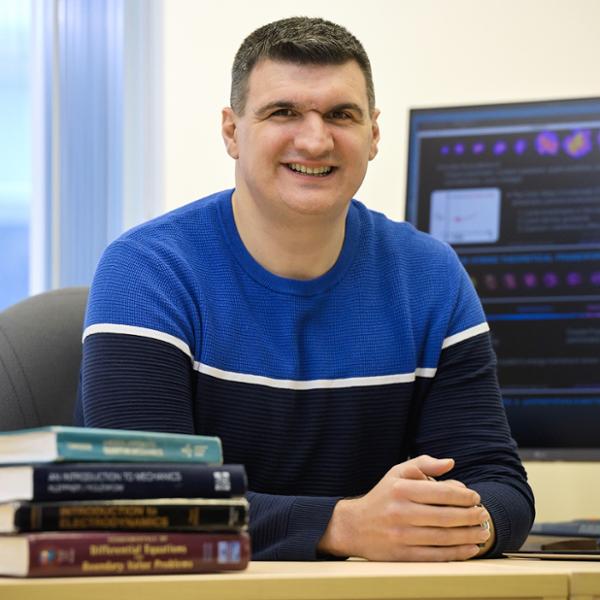Gojko Vujanovic

Contact Info
Research Interests
- Nuclear media under extreme conditions
My research focuses on studying nuclear media under extreme conditions, such as those reached during the first few microseconds after the Big Bang. The high temperatures reached therein can be recreated in the laboratory using high-energy heavy-ion collisions taking place at the Relativistic Heavy Ion Collider at Brookhaven National Laboratory and the Large Hadron Collider at CERN. These two experimental facilities are trying to explain how the building blocks of strong nuclear force – the quarks, and the gluons – behave at temperatures high enough to produce a new state of matter: the Quark Gluon Plasma (QGP). Unlike electromagnetic plasmas composed of electrons and ions, the trillions of degrees Kelvin needed for the QGP to be formed can only be achieved in the laboratory for a very short period, about 10-22 seconds, before the quarks and the gluons recombine into bound states of the strong force, known as hadrons (e.g., protons, neutrons, pions, etc). However, as the QGP is strongly coupled, even such a short time is enough to leave an imprint on the distributions of hadrons measured experimentally.
The goal of my research is to combine many different fields of physics, i.e., thermodynamics/statistical mechanics, special relativity, and quantum mechanics, to describe the properties of the QGP and explain its evolution. Given the QGP’s short lifetime, the development of leading edge/highly optimized simulations is required in addition to theoretical progress. Thus, my research straddles formal theoretical developments and high-performance numerical simulations, ultimately using supercomputers in model-to-data comparisons.
My research focuses on the following directions:
- Studying what soft (low energy) and hard (high energy) probes tell us about QGP properties (e.g. shear and bulk viscosity, momentum diffusion, and so on),thus motivating improvements of their underlying theoretical formalisms
- Improving the dynamical description of the QGP itself, e.g., via novel formulations of fluid dynamics.
I am also a member of JETSCAPE Collaboration, a multi-disciplinary effort involving physics, mathematics, and computer science. An important goal of this Collaboration is to develop a model-agnostic modular framework that describes various aspects of QGP simulations. To do so, the framework provides a communication layer between modules simulating various physics of the QGP, as well as state-of-the-art simulation software for each physical process of interest, such as jet quenching, hydrodynamical simulations, hadronic transport evolution, and so on. Thus, to improve on a particular physical process of interest, one simply adds or replaces a JETSCAPE module, and the rest of the framework can be used to perform realistic comparisons with data.
If you are interested is theoretical developments or phenomenological simulations of the nuclear medium and its probes, please contact me. I am always on the lookout for students – graduate and summer undergraduates – as well as postdoctoral fellows.
Publications
Current Courses Taught
- Physics 322: Physical Optics and Electromagnetic (E/M) Radiation
- Physics 352: Mathemetical Physics II
- Physics 810: General Relativity
- Physics 811: Advanced Classical Mechanics
- Physics 890BB: Thermal Field Theory